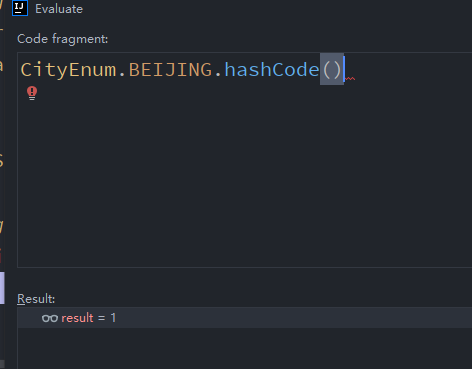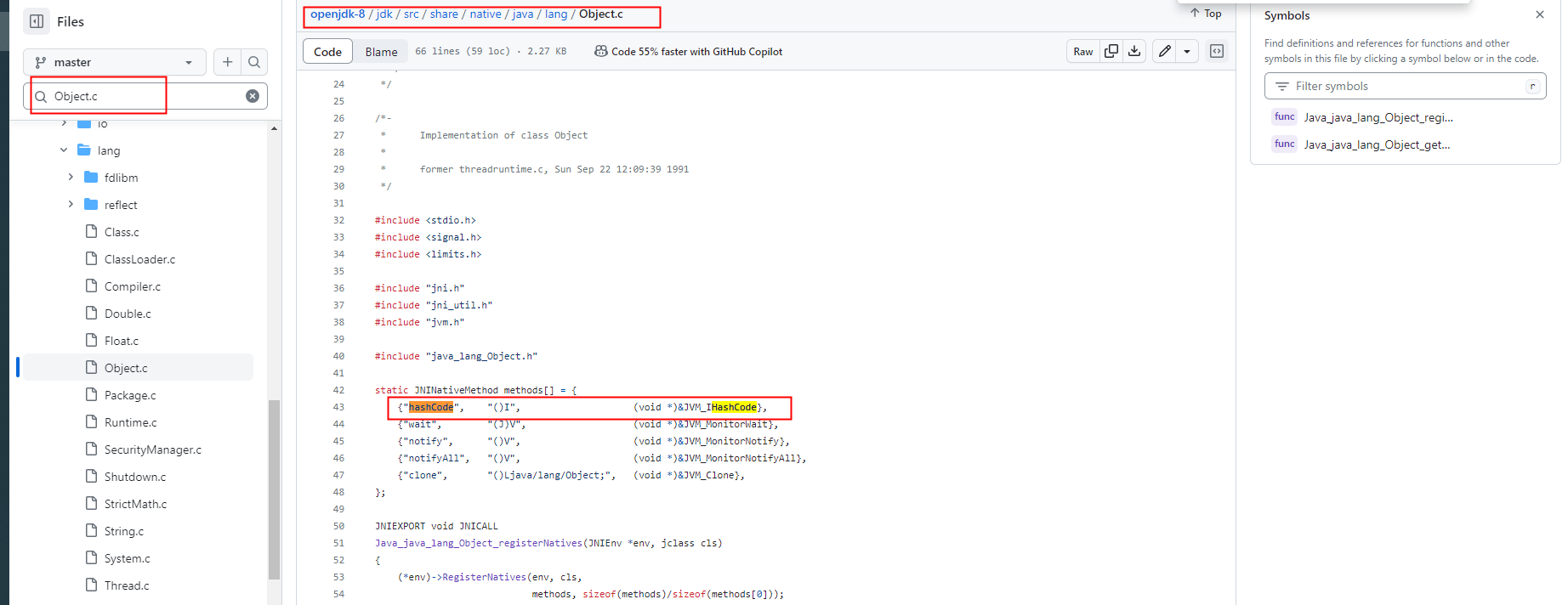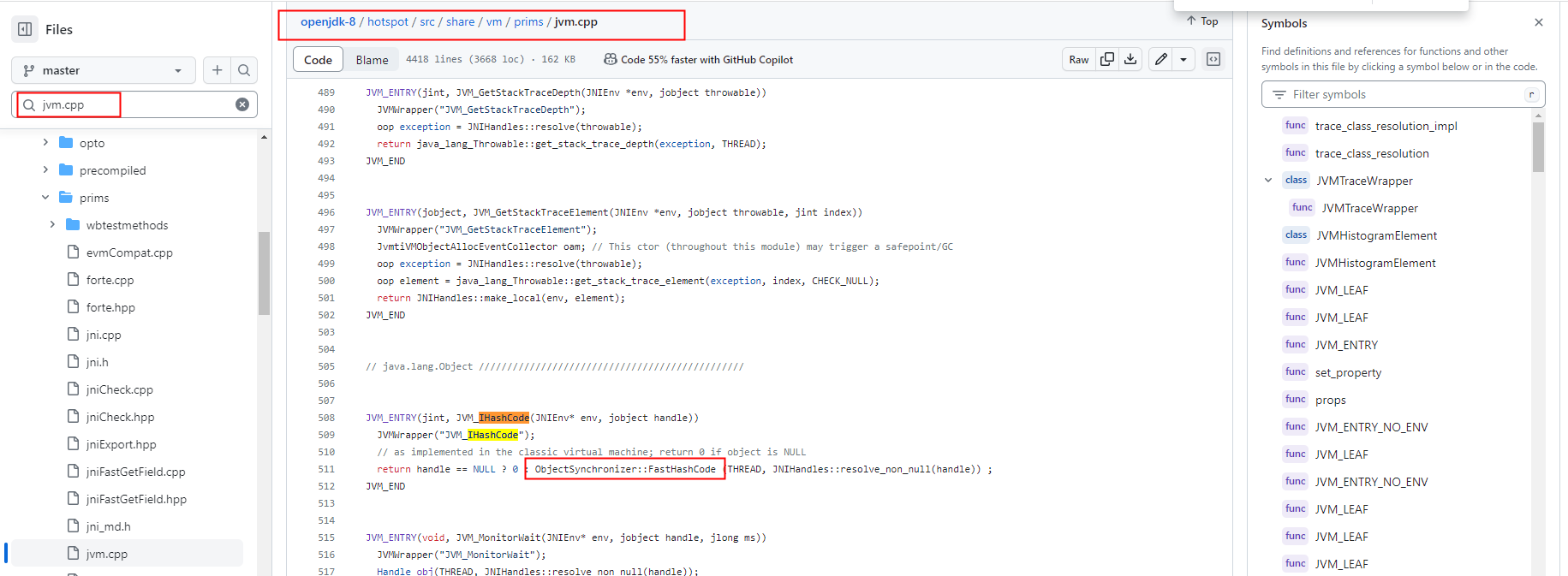一、原因分析
1.1 HashMap对象的遍历
HashMap的遍历是通过此类中字段table数组进行顺序遍历,原因如下所示:

1 #HashMap 迭代遍历源码 2 public final boolean hasNext() { 3 return next != null; 4 } 5 6 final Node<K,V> nextNode() { 7 Node<K,V>[] t; 8 Node<K,V> e = next; 9 if (modCount != expectedModCount) 10 throw new ConcurrentModificationException(); 11 if (e == null) 12 throw new NoSuchElementException(); 13 //遍历完此索引位置的所有冲突的Node(链表或者是红黑树结构) 14 if ((next = (current = e).next) == null && (t = table) != null) { 15 //索引位置遍历完成,继续顺着table数组遍历下一个索引位置 16 do {} while (index < t.length && (next = t[index++]) == null); 17 } 18 return e; 19 }
而具体每个对象落到table数组的哪个索引位置,是通过hashCode值和HashMap的容量求余得到,所以其遍历顺序完全依赖hashCode值,所以我们分析下集合的对象的hashCode值是否是动态变化的,如果是变化的,其在table数组中的位置就是动态可变的,那遍历顺序也是动态可变的,从而导致相同产品的不同版本是随机相互覆盖的。分析过程如下所示:
我们自定义存储在HashMap集合中的元素类对象,如下所示:

1 public class Personal { 2 private String name; 3 private String age; 4 private CityEnum city; 5 6 public Personal(String name, String age, CityEnum city) { 7 this.name = name; 8 this.age = age; 9 this.city = city; 10 } 11 12 public String getName() { 13 return name; 14 } 15 16 public void setName(String name) { 17 this.name = name; 18 } 19 20 public String getAge() { 21 return age; 22 } 23 24 public void setAge(String age) { 25 this.age = age; 26 } 27 28 public CityEnum getCity() { 29 return city; 30 } 31 32 public void setCity(CityEnum city) { 33 this.city = city; 34 } 35 36 @Override 37 public boolean equals(Object o) { 38 if (this == o) return true; 39 if (o == null || getClass() != o.getClass()) return false; 40 Personal personal = (Personal) o; 41 return Objects.equals(name, personal.name) && Objects.equals(age, personal.age) && city == personal.city; 42 } 43 44 @Override 45 public int hashCode() { 46 CityEnum city = this.getCity(); 47 int hashCode = 0; 48 hashCode += this.getCity().hashCode()+this.getName().hashCode()+this.getAge().hashCode(); 49 return hashCode; 50 } 51 }
以及其依赖的枚举字段city:

1 public enum CityEnum { 2 BEIJING, 3 SHANGHAI, 4 HENAN, 5 TIANJIN 6 }
由于Personal此类重写了hashCode()方法:

1 public int hashCode() { 2 int h = hash; 3 if (h == 0 && value.length > 0) { 4 char val[] = value; 5 6 for (int i = 0; i < value.length; i++) { 7 h = 31 * h + val[i]; 8 } 9 hash = h; 10 } 11 return h; 12 }
其上生成hashCode使用的字段包括两种数据类型(String和CityEnum),他们各自的hashCode的实现如下所示:
1. String类重写的hashCode方法如下所示:

1 public int hashCode() { 2 int h = hash; 3 if (h == 0 && value.length > 0) { 4 char val[] = value; 5 6 for (int i = 0; i < value.length; i++) { 7 h = 31 * h + val[i]; 8 } 9 hash = h; 10 } 11 return h; 12 }
对于String的hashCode方法,从源码可以看出,只和其值有关系,所以相同的字符串在不同的进程之间永远是相同的,不存在变化的情况。
2. CityEnum类没有实现hashCode方法,使用的是Object类的本地hashCode方法,如下所示:
public native int hashCode();
而对于CityEnum类来说,由于使用的是其父类Object的native方法hashCode(),对于相同ServiceName枚举值,此方法的返回值在不同进程之间是不同的。
opjdk的实现源码方法可追溯到方法FastHashCode:https://github.com/bpupadhyaya/openjdk-8/blob/master/hotspot/src/share/vm/runtime/synchronizer.cpp,具体生成hashCode的方法如下所示:

1 static inline intptr_t get_next_hash(Thread * Self, oop obj) { 2 intptr_t value = 0 ; 3 if (hashCode == 0) { 4 // This form uses an unguarded global Park-Miller RNG, 5 // so it's possible for two threads to race and generate the same RNG. 6 // On MP system we'll have lots of RW access to a global, so the 7 // mechanism induces lots of coherency traffic. 8 value = os::random() ; 9 } else 10 if (hashCode == 1) { 11 // This variation has the property of being stable (idempotent) 12 // between STW operations. This can be useful in some of the 1-0 13 // synchronization schemes. 14 intptr_t addrBits = cast_from_oop<intptr_t>(obj) >> 3 ; 15 value = addrBits ^ (addrBits >> 5) ^ GVars.stwRandom ; 16 } else 17 if (hashCode == 2) { 18 value = 1 ; // for sensitivity testing 19 } else 20 if (hashCode == 3) { 21 value = ++GVars.hcSequence ; 22 } else 23 if (hashCode == 4) { 24 #cast_from_oop将obj对象的地址(引用)转换为整数类型 25 value = cast_from_oop<intptr_t>(obj) ; 26 } else { 27 // Marsaglia's xor-shift scheme with thread-specific state 28 // This is probably the best overall implementation -- we'll 29 // likely make this the default in future releases. 30 unsigned t = Self->_hashStateX ; 31 t ^= (t << 11) ; 32 Self->_hashStateX = Self->_hashStateY ; 33 Self->_hashStateY = Self->_hashStateZ ; 34 Self->_hashStateZ = Self->_hashStateW ; 35 unsigned v = Self->_hashStateW ; 36 v = (v ^ (v >> 19)) ^ (t ^ (t >> 8)) ; 37 Self->_hashStateW = v ; 38 value = v ; 39 } 40 41 value &= markOopDesc::hash_mask; 42 if (value == 0) value = 0xBAD ; 43 assert (value != markOopDesc::no_hash, "invariant") ; 44 TEVENT (hashCode: GENERATE) ; 45 return value; 46 }
默认hashCode值是多少?

hashCode=5时,将走else中的逻辑,此逻辑使用Marsaglia's xor-shift 算法,这个算法的核心思想是通过位操作和状态变量的混合,生成看似随机的哈希码。这样的哈希 码通常用于散列表等数据结构中,以平均分散数据,降低哈希冲突的概率。由于哈希码的生成是基于对象地址和线程状状态,因此对于相同对象和相同线程状态,生成的 哈希码是一致的,但不同对象和不同线程可能会生成不同的哈希码。
也可在启动java进程中加入-XX:hashCode=2指定使用哪种hashCode生成算法,如下所示:


也可参考这篇文章去理解:https://juejin.cn/post/6873019885597753357
验证1,2两部分的分析,举例如下:

1 public static void main(String[] args) { 2 System.out.println("1".hashCode()); 3 System.out.println("12".hashCode()); 4 System.out.println(CityEnum.BEIJING.hashCode()); 5 }
本地在两个项目下执行以上main函数,输出结果如下所示:
#进程1
49
1569
1313953385
#进程2
49
1569
2081191879
1.2 HashMap对象的扩容
实际上HashMap对象扩容之后,也可能导致两个元素的遍历先后顺序发生变化,映射到业务上就是,当打包的产品的数量达到扩容的阈值时,也会发生不同版本的相同产品的遍历顺序发生变化,扩容方法源码如下所示,可通过其中注释理解其含义:

1 final Node<K,V>[] resize() { 2 Node<K,V>[] oldTab = table; 3 int oldCap = (oldTab == null) ? 0 : oldTab.length; 4 int oldThr = threshold; 5 int newCap, newThr = 0; 6 if (oldCap > 0) { 7 if (oldCap >= MAXIMUM_CAPACITY) { 8 threshold = Integer.MAX_VALUE; 9 return oldTab; 10 } 11 else if ((newCap = oldCap << 1) < MAXIMUM_CAPACITY && 12 oldCap >= DEFAULT_INITIAL_CAPACITY) 13 newThr = oldThr << 1; // double threshold 14 } 15 else if (oldThr > 0) // initial capacity was placed in threshold 16 newCap = oldThr; 17 else { // zero initial threshold signifies using defaults 18 newCap = DEFAULT_INITIAL_CAPACITY; 19 newThr = (int)(DEFAULT_LOAD_FACTOR * DEFAULT_INITIAL_CAPACITY); 20 } 21 if (newThr == 0) { 22 float ft = (float)newCap * loadFactor; 23 newThr = (newCap < MAXIMUM_CAPACITY && ft < (float)MAXIMUM_CAPACITY ? 24 (int)ft : Integer.MAX_VALUE); 25 } 26 threshold = newThr; 27 @SuppressWarnings({"rawtypes","unchecked"}) 28 Node<K,V>[] newTab = (Node<K,V>[])new Node[newCap]; 29 table = newTab; 30 if (oldTab != null) { 31 for (int j = 0; j < oldCap; ++j) { 32 Node<K,V> e; 33 if ((e = oldTab[j]) != null) { 34 oldTab[j] = null; 35 //此索引位置无hash冲突 36 if (e.next == null) 37 newTab[e.hash & (newCap - 1)] = e; 38 //此索引位置有hash冲突,且是红黑树数据结构 39 else if (e instanceof TreeNode) 40 ((TreeNode<K,V>)e).split(this, newTab, j, oldCap); 41 //此索引位置有hash冲突,且是链表数据结构 42 else { // preserve order 43 //保持索引位置不变的链表的头尾 44 Node<K,V> loHead = null, loTail = null; 45 //索引位置迁移到高位(当前索引位置+oldCap)的链表的头尾 46 Node<K,V> hiHead = null, hiTail = null; 47 Node<K,V> next; 48 do { 49 next = e.next; 50 //(e.hash & oldCap) == 0时,e.hash &(oldCap-1)=e.hash &(2oldCap-1) 51 if ((e.hash & oldCap) == 0) { 52 if (loTail == null) 53 loHead = e; 54 else 55 loTail.next = e; 56 loTail = e; 57 } 58 //(e.hash & oldCap) != 0时,e.hash &(oldCap-1) + oldCap = e.hash &(2oldCap-1) 59 else { 60 if (hiTail == null) 61 hiHead = e; 62 else 63 hiTail.next = e; 64 hiTail = e; 65 } 66 } while ((e = next) != null); 67 if (loTail != null) { 68 loTail.next = null; 69 newTab[j] = loHead; 70 } 71 if (hiTail != null) { 72 hiTail.next = null; 73 newTab[j + oldCap] = hiHead; 74 } 75 } 76 } 77 } 78 } 79 return newTab; 80 }

1 #treeNode遍历 2 final void split(HashMap<K,V> map, Node<K,V>[] tab, int index, int bit) { 3 TreeNode<K,V> b = this; 4 // Relink into lo and hi lists, preserving order 5 TreeNode<K,V> loHead = null, loTail = null; 6 TreeNode<K,V> hiHead = null, hiTail = null; 7 int lc = 0, hc = 0; 8 for (TreeNode<K,V> e = b, next; e != null; e = next) { 9 //从这里可以看出jdk1.8,当链表数据量大于8时转换为红黑树,但是还保留了其链表结构(感兴趣的可以从push方法中发现),此部分遍历用的就是链表的结构 10 next = (TreeNode<K,V>)e.next; 11 e.next = null; 12 if ((e.hash & bit) == 0) { 13 if ((e.prev = loTail) == null) 14 loHead = e; 15 else 16 loTail.next = e; 17 loTail = e; 18 ++lc; 19 } 20 else { 21 if ((e.prev = hiTail) == null) 22 hiHead = e; 23 else 24 hiTail.next = e; 25 hiTail = e; 26 ++hc; 27 } 28 } 29 30 if (loHead != null) { 31 if (lc <= UNTREEIFY_THRESHOLD) 32 tab[index] = loHead.untreeify(map); 33 else { 34 tab[index] = loHead; 35 if (hiHead != null) // (else is already treeified) 36 loHead.treeify(tab); 37 } 38 } 39 if (hiHead != null) { 40 if (hc <= UNTREEIFY_THRESHOLD) 41 tab[index + bit] = hiHead.untreeify(map); 42 else { 43 tab[index + bit] = hiHead; 44 if (loHead != null) 45 hiHead.treeify(tab); 46 } 47 } 48 }
1.2.1 基本知识点
哈希值对链表数组的长度取模,得到值所在的索引位置,里面使用位运算(&)代替普通的(%)运算。
1. 为什么[用位运算(&)代替普通的(%)运算?
位运算(&)效率要比取模运算(%)高很多,主要原因是位运算直接对内存数据进行操作,不需要转成十进制,因此处理速度非常快。
2. 位运算(&)为什么能代(%)运算?
从2进制角度来看,X / 2^n相当于 X >> n,即把X右移n位,此时得到了X / 2^n的商,而被移掉的部分(后n位),则是X % 2^n,也就是余数,想获取后三位的值只需要与2^n-1求与即可获得,所以,X % 2^n = X & (2^n - 1),也就是说, 一个数对 2^n 取模相当于一个数和 (2^n - 1) 做按位与 运算。
1.2.2 扩容导致遍历顺序变化
定义personal1和Personal2两个对象,如下所示:
Personal personal1=new Personal("张三","20",CityEnum.BEIJING);
Personal personal2=new Personal("李四","21",CityEnum.SHANGHAI);
假设personal1和Personal2的hashCode分别为9和4,HashSet<Personal> 对象的初始容量为8
1. 假设某次请求中,map中的元素个数小于8*0.75=6,迭代器遍历map时,由于9%8=1,4%8=4,那么两个产品的遍历先后顺序是Personal1,Personal2;
2. 假设某次请求中,map中的元素个数大于8*0.75=6,达到扩容阈值,则会执行resize() 方法,map的容量变成16,迭代器遍历map时,由于9%16=9,4%16=4,那么两个产品的遍历先后顺序是Personal2,Personal1;
由上可知,当发生扩容是,两个相同的对象放入扩容前后的集合中的索引位置发生变换,迭代遍历先后顺序可能变换;
二、结论
由第二部分分析过程可知,由于HashSet<Personal>中的Personal对象,由于有个字段是枚举类没有实现父类Object的hashCode方法而使用父类的native hashCode()方法获取hash值,同一个元素对象其hash值在不同进程间是不同的,所以导致存储相同个数(大于1)的Personal的集合对象HashSet<Personal>,在不同进程间对其进行迭代遍历的顺序不同。如果像保证集合中自定义元素的遍历顺序在任何进程间不变,需要重写hashCode方法,是得其值只与其.toString值有关,而与地址等动态变量无关即可。
三、java中native源码查找
以Object的hashCode()方法为例:
1. 下载openjdk源码或从github中查找,我这以github中使用为例;
2. GitHub中查找https://github.com/bpupadhyaya/openjdk-8/tree/master/hotspot源码;
3. 搜索到Object.c源码文件,并查找hashCode字眼,如下所示:

4. 由上可知,hashCode方法实际是调用的jvm.cpp文件的IHashCode方法,继续搜索jvm.cpp文件,如下所示:

5. 由上图可知,调用的是Synchronizer.cpp类的FastHashCode 方法,搜索如下所示,由此找到hashCode的真正实现源码。

